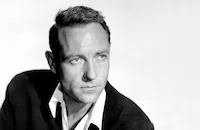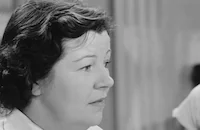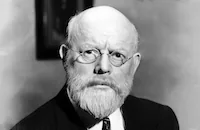Easter Parade

Brief Synopsis
Cast & Crew
Charles Walters
Judy Garland
Fred Astaire
Peter Lawford
Ann Miller
Jules Munshin
Film Details
Technical Specs

Synopsis
On a spring day in 1912, Don Hewes, a dancer living in New York City, learns that his dancing partner, Nadine Hale, has signed a contract to appear in a Broadway show and will no longer be performing with him. Don, who is in love with Nadine, is crushed by the announcement and goes to a bar to drink away his sorrows. At the height of his drunkeness, Don brags that he does not need Nadine in his act and that he can make a star out of any common showgirl. Hannah Brown, a showgirl at the bar, soon catches Don's attention, and he hastily offers her $100 a week to be his new dancing partner. Don later regrets having made the impulsive offer, but keeps his Easter Sunday appointment with Hannah at a dance studio. Don puts Hannah through a difficult rehearsal session, struggling in vain to teach her his dance moves. Afterward, Hannah and Don take a stroll down Fifth Avenue, where they see Nadine walking her dogs and commanding a great deal of attention with her poise. Hannah does not know Nadine but she is awed by her beauty and style. Don passes by Nadine without greeting her, and then tells Hannah that in exactly one year she will be a bigger star than Nadine. After buying a new wardrobe for Hannah, Don changes her stage name to "Juanita" to make her seem more exotic. Hannah eventually falls in love with Don, but Don is too distracted by his feelings for Nadine to notice her interest. Jonathan Harrow, III, a friend of Don, tries to forge a reconciliation between Don and Nadine, but his efforts end in failure. Following Don and Hannah's disappointing first performance, Don realizes that he has been trying to make Hannah into a carbon copy of Nadine, and that she is not suited for that role. Instead, he decides to let Nadine be herself and perform in the showgirl style that she knows best. Jon, meanwhile, falls in love with Hannah, though Don remains her only romantic interest. One day, Hannah and Don audition for the "Ziegfeld Follies," but when Don realizes that Nadine has been cast as the star of the show, he turns down the part. After a year of polishing their act, Don and Hannah are signed to their first big show, which is set to open in New York on Easter. While celebrating the new contract with a romantic dinner, Don confesses to Hannah that he is in love with her. They give a flawless performance on opening night, and afterward Don takes Hannah to see Nadine perform in the "Ziegfeld Follies." During her first number, Nadine steps into the audience and takes Don in her arms and dances with him. Hannah sadly concludes that Don is still in love with Nadine and leaves the theater. A series of misunderstandings further alienates Don and Hannah, but Jon intervenes and eventually forces a reconciliation. Then, remembering the Easter day promise that Don made to her exactly one year earlier, Hannah, dressed in her best clothes, walks down Fifth Avenue just as Nadine did, and attracts the admiring attention of all the people she passes.

Director

Charles Walters
Cast

Judy Garland

Fred Astaire

Peter Lawford

Ann Miller

Jules Munshin

Clinton Sundberg
Richard Beavers
Jeni Legon
Jimmy Bates
Dick Simmons
Patricia Jackson
Bobbie Priest
Dee Turnell

Joy Lansing
Elaine Sterling
Patricia Vaniver
Shirley Ballard

Ruth Hall
Gail Langford

Lola Albright
Patricia Walker
Marjorie Jackson
Lynn Romer
Jeanne Romer
Helene Heigh

Margaret Bert
John Albright
Johnny Walsh
Dick Paxton
George Noisom
Wilson Wood
Tay Dunn
Murray Leonard
John Gannon
Lane Allan
Fern Eggen
Hector And His Pals
Peter Chong
Nolan Leary
Angi O. Poulos
Joe Kerr
Jimmy Dodd
Robert E. O'connor
Albert Pollet
Doris Kemper
Frank Mayo
Harry Fox
Ralph Sanford
Sig Frohlich
Rhea Mitchell
Reginald Simpson

Howard Mitchell
Bob Jellison
Crew
Albert Akst
Robert Alton
Leo Arnaud
Irving Berlin
Dick Borland
James K. Brock
Jack Dawn
Roger Edens
Arthur Freed
Cedric Gibbons
Frances Goodrich
Frances Goodrich
Johnny Green
Sydney Guilaroff
Albert Hackett
Albert Hackett
Eddie Hubbell
Irene
Henri Jaffa
Natalie Kalmus
Arthur Krams
Sam Leavitt
Les Martinson
Warren Newcombe
Conrad Salinger
Douglas Shearer
Sidney Sheldon
Al Shenberg
Jack Martin Smith
Harry Stradling
Robert Tucker
Valles
Van Cleave
Edwin B. Willis
Wally Worsley

Photo Collections
Videos
Movie Clip



Trailer
Hosted Intro




Film Details
Technical Specs

Award Wins
Best Music Original Dramatic Score
Articles
Easter Parade
Easter Parade was inspired by the success of Paramount's 1946 hit Blue Skies, a combination of new and vintage songs by Irving Berlin that had starred Fred Astaire and Bing Crosby. Convinced that he'd written enough songs for a dozen other musicals, Berlin decided to shop around another idea based on his song catalogue, Easter Parade, and MGM was eager to pick up the project.
Initially, the film was to re-team the people behind The Pirate, writers Goodrich and Hackett, director Vincente Minnelli and stars Judy Garland and Gene Kelly. And that's when the trouble started.
Garland's nervous breakdown, which would eventually end her career at MGM, had started during work on The Pirate, when she grew jealous of the close working relationship between Kelly and her director husband. She'd even suspected a sexual relationship that wasn't there. After she completed the film, her psychiatrist suggested that she associated her problems at MGM with Minnelli. So five days into rehearsal for Easter Parade, he was replaced by former dancer Charles Walters.
Meanwhile Berlin had been working closely with the Hacketts to create a script built on his own memories of vaudeville. He was happy, but Walters took one look at the material and decided it was too harsh and mean-spirited. He got Kelly and Garland to call Freed, asking for someone to add a lighter touch to the script, so Freed hired Sidney Sheldon, who'd just won an Oscar for The Bachelor and the Bobby-Soxer (1947). Sheldon, who would go on to create the hit sitcom I Dream of Jeannie, would later claim to have done a complete overhaul on the script, while the Hacketts would insist he only added one scene.
Back at the rehearsal hall, the cast was having a few problems. Cyd Charisse, who was to have her first major role as the dancing partner who dumps Kelly in the first reel, broke her leg. So Mayer asked Freed to give the role to his protegee, Ann Miller, who had just signed with the studio. Then Kelly broke his ankle. At the time, he told the studio it happened during rehearsals. Years later, however, he admitted that he'd done it playing touch football.
Unable to hold the production up for five months waiting for Kelly's ankle to heal, Freed briefly considered casting the young Gene Nelson. Then he decided he needed a bigger name to work with Garland, so he called Fred Astaire, who had retired from the screen two years earlier. Before he would accept the role, however, Astaire called Kelly and asked him three questions: "Will this hurt your career?," "Do you think I can learn the dances?," and "Is there any chance you could do the picture?" When Kelly assured him this was the only way Easter Parade could get made, Astaire enthusiastically agreed.
Astaire and Garland got along beautifully, and with all the right people in place, the picture came together like a charm. Easter Parade opened in July 1948 (the delays had made it impossible to have the film ready for Easter) and became one of MGM's top-grossing films of the year, taking in over $6.8 million on an investment of $2.5 million. The film's success brought Astaire back into movies as an MGM star and gave Garland one of her signature tunes - the tramp's duet, "A Couple of Swells." Starting with her smash appearance at the Palace in 1951, in which she performed the duet with Easter Parade director Charles Walters, the number became a part of her repertoire, often followed by a poignant rendition of "Over the Rainbow," still in tramp costume.
Producer: Arthur Freed
Director: Charles Walters
Screenplay: Frances Goodrich, Albert Hackett, Sidney Sheldon
Based on a story by Francis Goodrich & Albert Hackett Cinematography: Harry Stradling, Sr.
Art Direction: Cedric Gibbons, Jack Martin Smith
Music: Irving Berlin
Principal Cast: Judy Garland (Hannah Brown), Fred Astaire (Don Hewes), Peter Lawford (Jonathan Harrow III), Ann Miller (Nadine Hale), Jules Munshin (Francois), Clinton Sundberg (Mike the Bartender).
C-104m. Closed captioning. Descriptive video.
by Frank Miller

Easter Parade
Quotes
A girl dancer has to be a peach.- Don Hewes
I suppose I'm a lemon!- Hannah Brown
Why didn't you tell me I was in love with you?- Don Hewes
Miss Brown, what idiot ever told you you were a dancer?- Don Hewes
You did.- Hannah Brown
What color are my eyes?- Hannah Brown
Brown.- Don Hewes
Trivia
Garland's husband Vincente Minnelli was originally slated to direct, but Garland's psychiatrist advised them not to work together.
The shedding feathered gown worn by Garland in one number is an in-joke reference to Ginger Rogers' problematic gown in Top Hat (1935) .
A Garland solo number, "Mr. Monotony", was cut from the film.
'Gene Kelly' was originally scheduled to play Don, but he unexpectedly broke his ankle. It was at his suggestion that he be replaced by Fred Astaire. Cyd Charisse was up for the role of Nadine, but her pregnancy forced her to drop out. She was replaced by 'Ann Miller' . Although she had been a star for years, 'Judy Garland' had never met Fred Astaire before, and was afraid to speak to him until they were properly introduced.
This is the second time that a character says to 'Judy Garland' : "Why didn't you tell me I was in love with you?" in a film. The first was 'Gene Kelly' in For Me and My Gal (1942).
Notes
According to a November 1947 New York Times article, composer and lyricist Irving Berlin was paid $600,000 for his contribution to film, which included the use of his name, his consultation on the story, the title of the picture and his songs. More than half of the songs performed in the Easter Parade were written by Berlin in the four decades prior to the film, and many of the songs were performed in various stage and film musicals. The songs that Berlin wrote especially for Easter Parade were: "It Only Happens When I Dance with You," "Better Luck Next Time," "Drum Crazy," "Stepping Out with My Baby," "A Couple of Swells," "A Fella With An Umbrella" and "Happy Easter." Another song, "Mr. Monotony," which was also written especially for the film, was not used. Berlin wrote the melody for the film's title song in 1917 and originally used it for a song entitled "Smile and Show Your Dimple." The song "Easter Parade" grew out of Berlin's reworking of "Smile and Show Your Dimple" for the 1933 revue As Thousands Cheer.
A February 1947 Hollywood Reporter news item announced that the following actors were cast in the film: Frank Sinatra, Gene Kelly, Kathryn Grayson and Red Skelton. An October 1947 Hollywood Reporter news item indicated that Fred Astaire took over the role originally intended for Kelly, who withdrew from the film one month before the start of production due to a broken ankle. The film marked the return to the screen of Astaire, who had announced his retirement from movies in 1946, after completing Blue Skies. A December 1947 New York Times article noted that Astaire only meant his "retirement" to be a "mental retirement" or a hiatus from the demands of creating new ideas and steps for dance numbers. Astaire appeared in many additional films from the late 1940s through the 1970s and did not completely retire from the screen until the early 1980s.
Easter Parade marked the motion picture debut of Broadway actor Jules Munshin, who appeared in a number of popular M-G-M musicals from the late 1940s through the late 1950s. The film also marked the film debut of Richard Beavers. According to publicity materials contained in the AMPAS Library production file, more than 700 extras were used in the film's Easter parade finale, which was filmed on a specially built set constructed on M-G-M's backlot. Publicity materials also noted that the M-G-M camera department, headed by John Arnold, was responsible for creating the first ever slow motion synchronization with sound. The slow motion effect, used in the "Steppin' Out with My Baby" sequence, features Astaire dancing in slow motion in front of a chorus moving and singing in real-time. A February 1948 Daily Variety article indicated that the final cost of Easter Parade was $3,000,000. It was the studio's top grossing picture of the year, taking in about $6,800,000 at the box office in its initial release.
According to an April 1949 Hollywood Reporter news item, Freed was one of two recipients of the Inter-American Music League's award honoring the "greatest contributions to music in 1948." The award was given in recognition of Freed's work on Easter Parade and Words and Music (see below). Sidney Sheldon, Frances Goodrich and Albert Hackett received the award for "Best-Written American Musical" at the first Annual Screen Writers Guild Awards. Roger Edens (who did not receive screen credit) and Johnny Green won an Academy Award for Best Scoring of a Musical Picture.
According to a biography of Judy Garland, Berlin originally offered the film rights to Easter Parade to Twentieth Century-Fox. Fox rejected Berlin's offer because of the high price he was asking and because he demanded a share of the film's profits. Modern sources note that Vincente Minnelli was originally set to direct the film but was taken off the picture just before it went into production. Minnelli's removal, according to modern sources, came at the urging of Dr. Kupper, a psychiatrist who was treating Minnelli's then wife, Judy Garland. Kupper reportedly warned M-G-M that Garland, who had just been released from a sanitarium where she was treated for mental distress and drug dependency, could not withstand the pressures of being directed by her husband. Berlin is quoted in a biography of Freed as having said that he "worked very closely on the story with Hackett" and that Edens was "responsible for the whole musical context of the picture." The Freed biography also indicates that noted playwright Guy Bolton contributed to the screenplay. According to a modern source, Albert Sendrey did the musical orchestrations for the film. According to a biography of Ann Miller, Miller replaced Cyd Charisse, who had pulled a tendon in her leg and could not work on the picture.

Miscellaneous Notes
Released in United States Summer July 8, 1948
Released in United States on Video March 14, 1989
Released in United States November 1990
Released in United States June 1994
Released in United States 1996
Shown at Laemmle's Monica in the series "MGM Musical Festival" in Los Angeles November 2-8, 1990.
Lola Albright had a bit part in the film.
Released in United States Summer July 8, 1948
Released in United States on Video March 14, 1989
Released in United States November 1990 (Shown at Laemmle's Monica in the series "MGM Musical Festival" in Los Angeles November 2-8, 1990.)
Released in United States June 1994 (Shown in New York City (Anthology Film Archives) as part of program "25 Years of Exposure" June 17-23, 1994.)
Released in United States 1996 (Shown in Los Angeles (Laemmle's Monica 4-Plex) as part of program "Turner's Tuners: Great Musical's From the Turner Library" October 12 - December 29, 1996.)














